This time of year, when the sun goes down early, neon comes into focus. While neon lighting may be losing out to LED and lighted plastic in the commercial world, the classic neon signs of New York City seem to be glowing particularly bright at this point in time. Two neon connoisseurs have taken it upon themselves to make sure these signs get the admiration they deserve.
“Finding all these vibrant, living neon signs helped me fall in love with the city again.”
This week, Thomas E. Rinadli published his book, “New York Neon,” which offers a photo tour of 200 signs including the details of each sign’s origin. Last fall, Kirsten Hively launched a free iPhone app called Project Neon, which allows users to locate, rate, and learn a little of the personal history of 120 New York signs. But the rising neon nostalgia isn’t limited to the Big Apple. A month ago, the Neon Museum, which preserves the spectacular animated neon casino signs from the mid-century Las Vegas strip, finally opened its doors after 16 years of planning.
We talked to Hively, an architect by trade who started snapping photos of classic New York neon signs two years ago this December. In the following year, she launched her Project Neon blog, a Google map, and a Kickstarter that raised more than $5,000 for her app. She explained why neon signs have such an irresistible allure that she’s felt compelled to photograph more than 800 so far.
Collectors Weekly: What inspired you to start Project Neon?

Top: Animated neon advertises the Wonder Wheel ride at Coney Island. Above: Naturally, New York has some great pizza-related neon, like the sign for Stella’s in Chelsea. Photos by Hively.
Kirsten Hively: I’ve loved neon signs for a long time. When I would travel to cities like Portland or Chicago, I would take photos of neon signs and print them to hang up on my wall. Two years ago, I read that it was the 100th anniversary of the debut of the modern neon sign at the Paris Motor Show. It struck me then that I didn’t have a single photo of neon signs in New York. I think I took it for granted that I could see those signs any day. But those classic signs aren’t necessarily permanent.
“We all have our own personal maps of the places we care about, and neon signs often overlap with these memories.”
At the time, I had just started a new job on the Upper East Side, in a neighborhood I’d never spent much time in. Getting out of work at 5 p.m., it was pitch-black outside. So I thought, “Maybe I’ll go take photos of those nice signs near my office”—at the Cork & Bottle liquor store and Goldberger’s Pharmacy. I figured I’d walk around the neighborhood. I vaguely remembered another up on 86th Street, at Papaya King. After I found that one, I ended up walking for hours and hours—and taking so many photos. Later, I went home and put them up on my Flickr.
A couple nights later, I went out to the Upper West Side and spent even more hours wandering around. I didn’t get to everything, but I got obsessive about taking photos of neon signs and marking where they were. When I had searched for other people’s photos of neon signs online, often the caption wouldn’t say where the image was taken. So I tried to be careful about always documenting the address of the place.

Russ & Daughters on the Lower East Side has a pair of blue and yellow fish. Photo by Hively.
I still haven’t taken photos of all the neon signs in New York City, and there are still some neighborhoods I haven’t had time to wander around in. Some signs are harder capture than others. Take Block Pharmacy, for example. That one was really hard to photograph because the pharmacy closes early. It’s only in the middle of winter that you can see the sign light up. Twice, when I was trying to get it, I saw it lit up from a distance, but by the time I got close enough to photograph it, it would turn off.
Collectors Weekly: Did you start the blog right away?
Hively: No. First, I just took a lot of photos and mapped them. Then, I got a little sad that I was flying past all of these things. I was trying to shoot as many as I could in a night. But I wanted to go back and spend more time at each place, especially because a lot of these are small, independent shops, pharmacies, or bars. A few chains use neon, but the nicer signs tend to be for small shops, and I wanted to support their businesses. So I started the blog to as an opportunity to go back and slow down a little bit after my frantic running all over the city. Each week, I would visit a particular business and talk about that place in my blog. It was a great experience to go into these little pharmacies and fast-food places like Papaya King. Some of them I had visited maybe once or twice before, but with a lot of the shops, I had admired the sign but I had never gone in.
Collectors Weekly: It sounds like a great way to get to know the city.

Block Drugstore in the East Village closes early, so its sign is rarely lit. Photo by Hively.
Hively: Absolutely. I definitely went to neighborhoods that I had never been to, or that I had passed through in the daytime but had never seen at night. I would do some research to find one good sign, and then just wander around that neighborhood for a couple of hours and see what else I’d see. It gave me more in-depth knowledge of the city and its history.
Some businesses with neon signs had been around for a long time, but some I came across had changed hands, which is even more interesting. Often, the new owners would leave the neon sign up, even though it’s not the official name of the business anymore. Everyone still knows it by the name on the neon sign.
Collectors Weekly: What do you like about neon?

Hively found this sign at Pete’s Hot Dog Stand traveling in Newburgh, New York. Photo by Hively.
Hively: Neon signs are a fascinating combination of a high-tech chemical reaction that seems magical and an artisanal hand-crafted good. When you look closely at the letters, you can often see that no two are exactly the same because they’re usually handmade. Plus, the quality of the light from a neon sign is just so amazing.
“If you flip all the switches, you get this incredible rainbow radiating out of the suitcase.”
I like how a neon sign becomes attached to a place, especially the big, elaborate, animated signs. So even if you haven’t ever been in the store, you know the sign, and you can direct people based on the sign. People will say things like, “Turn left at the neon sign” or “It’s two doors past the neon sign.” That sense of place is what makes the best signs.
People sometimes write in and tell me stories about their favorite signs. They’ll say, “This milestone happened to me right by that sign.” Or, “I remember walking by that sign on this important day.” I love hearing those stories. We all have our own personal maps of the places we care about. Neon signs overlap with a lot of people’s memories because they’re so visual. It’s doubly so when the sign is attached to a wonderful place that you’re happy going to and supporting.
Collectors Weekly: Can you give me a little bit of the history of neon?

The Dublin House Irish Pub in the Upper West Side is famous for its giant harp and animated lettering. Photo by Hively.
Hively: Scientists first discovered neon gas in 1898. Then, in a few phases, chemists figured out how to extract neon from the air. You can’t make neon, because it’s an element, a noble gas. It’s just in the air. The relatively affordable process of extracting neon gas from the air requires you to chill the air until it becomes liquefied and then slowly heat it. Each gas has a different temperature at which it returns to a gas form, so you can separate the gases this way.
A French-American inventor, Georges Claude, who first demonstrated his neon lighting at the Paris Motor Show in December 1910, patented this extraction process, as well as many of the electrical components that send voltage into the glass tubes and causes the gas to glow. Since he was also a business mastermind, Claude had a monopoly on neon-sign production for many years.
Collectors Weekly: What color is neon?

An example of the rainbow effect in a vintage neon-salesman suitcase. Courtesy of Hively.
Hively: Neon gas is red, but neon signs use other gases, too. Different noble gases produce different colors. Argon, which can make a bright blue or light lavender color, is the most common. Xenon, krypton, and helium are also used but less often. You can also put a gas in a tube colored with a phosphorescent powder coating. So if you put neon in a yellow tube, you get an orangish color.
One amazing relic of the golden age of neon are the suitcases carried by neon salesmen. They contained every color they could make. The suitcases are so beautiful. You open them up, and there’s a little switch for each tube. If you turn them all on—which you’re not really supposed to do—you just get this incredible rainbow radiating out of the suitcase. It must have been so magical when a salesman walked into a little shop and opened up his suitcase, especially when neon signs were first starting to catch on.
Collectors Weekly: What was the golden age of neon?

When Colony Music closed, the neon jumping girl was removed. Photo by Hively.
Hively: I’d say the ’40s through the early ’60s maybe. Times Square was full of neon at that point, as was L.A., Paris, and obviously, Las Vegas. Surprisingly, even Portland has beautiful neon signs. In the golden age of neon, people wanted to make the biggest signs, which isn’t true now.
During the mid-century, neon companies made these spectacular, gigantic signs, and they were also creative about animation and color. Business owners wanted real showstoppers, and crowds would gather for the unveiling the magical new sign.
Now, the remaining Times Square neon signs get drowned out by all the giant LED displays. It’s actually hard to take pictures of the signs in Times Square because it’s like daylight out at night. The settings I use on my camera are as if I were taking the picture in sunlight because the LEDs are so bright. Generally, in the photos I take, you see the sign, but everything else is dark. The chaos of the city is a little bit dimmed so the neon sign can shine through. But in Times Square it’s hard to get that.
Collectors Weekly: In old Times Square, a lot of the neon was advertising X-rated peep shows and porn shops, right?
Hively: There aren’t that many porn stores left in Times Square, because former Mayor Rudolph Giuliani shut down most of them. The few remaining are mostly on the periphery of Times Square. Gotham City Peep Shows still has a nice neon sign of a lady reclining. Recently, I was walking by that sign, and I noticed her hair color changed from blonde to red. Now, I have to go take a new picture.

The alluring lady at Gotham City Peep Shows recently got a new hair color. Photo by Hively.
The peep shows and the porn shops are not my favorite signs to take pictures of. When you stand in front of a porn shop with a camera, people start looking at you angrily. When I use a 50mm lens, I have to stand back farther than you’d think, so people often think I’m taking their picture. They think I’m documenting who’s going in and out and I’m going to send the photo to the police. A couple of times people will yell at me, “If you want to take my picture you should ask.” I’ll say, “You are so not in this picture.” As soon as I explain what I’m doing, they get really interested, and say “That’s so great! I love neon signs!”
Collectors Weekly: Is there a particular trick to photographing neon?
Hively: It can be difficult with a point-and-shoot camera because the settings of the camera don’t understand the brightness of the neon compared to the darkness behind it. You’ll often get a blurry-looking photo, but it’s not actually blurry. The blur is the glow of the sign. I almost always use a 50mm lens because it has a wide aperture so it can take a relatively quick picture even when it’s pretty dark. Mostly, it’s a matter of practice and figuring out the settings that work best. When I was starting this project, I would take a lot of photos of each sign, trying it with different settings. It’s often hard to focus. I find that the auto-focus doesn’t always work well, especially with the bright, reddish signs. Sometimes, I have to manually focus it.

The neon sign in the window at Sunny’s Bar in Red Hook, Brooklyn, was damaged by Hurricane Sandy. Photo by Hively.
I figured it out by trial and error. Also, I have a zoom lens that I bring with me. If it’s a really long sign across the whole storefront, I can use that lens. But I’ve never liked the photos it takes quite as much as the 50mm lens. When I use the 50mm lens, I can’t zoom in or out at all, so I end up standing in the street at night, which is tricky when I’m taking a photo and not looking for cars. Since winter is the best time to do this because the nights are longer, I’ve spent a lot of time standing in snow banks and icy puddles to take these photos.
Collectors Weekly: How has your iPhone app been doing?
Hively: Good. I need to make some updates because, sadly, some of the signs in the app are gone. I think the app appeals to two different sets of people. People in New York can discover new signs they didn’t know about or find out where signs they’ve only seen photos of are located. I’ve also heard from a lot of people who don’t live in New York but get into it as armchair travel. They can go to all these different neighborhoods in New York by seeing the photos. It’s an interesting, specific way to look at the city. But it’s also broad because it’s all over, in every borough.
Collectors Weekly: How many signs are in the app right now?

The sign at Little Cupcake Bakeshop, which just moved to a new location in SoHo, is an example of a small business putting up a new neon sign. Photo by Hively.
Hively: There are about 120. I couldn’t put more signs in it, because it would have taken forever to load. If it weren’t a matter of making the app work well, I would have put all 800 in. As it is, it’s a selected-highlights version.
I definitely put my favorite signs in there. For certain types of signs, like shoe-repair signs and Chinese takeout signs, where there are a million of them of all over the city, I tried pick ones that I thought were representative of a whole class of signs. Other than that, I mostly included signs that I thought people would enjoy in different neighborhoods. So whatever part of town you’re in, there’s a sign that’s not too far away from you. I’m happy to put in new neon signs, too. There aren’t so many new signs that are interesting, though. They tend to be straightforward.
Collectors Weekly: What other kinds of lighted signs do you see?
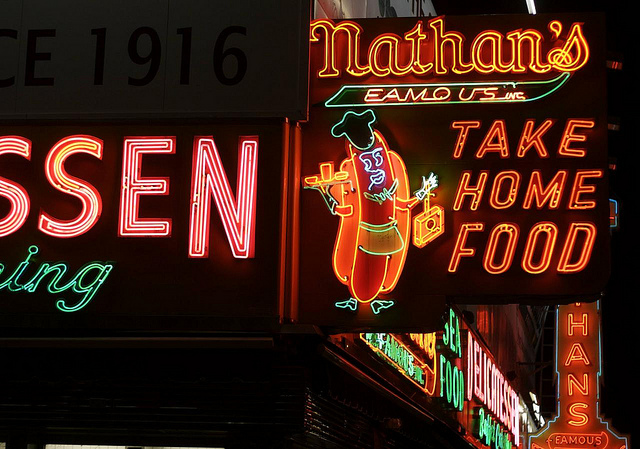
Nathan’s Famous Hot Dogs chain has a particularly elaborate neon sign on the corner of Surf and Stillwell in Coney Island. Photo by Hively.
Hively: There used to be incandescent signs, which used regular light bulbs. Some plastic signs now are lit with fluorescent bulbs. Modern signs that are big lighted plastic letters, like Target signs, often have neon behind them, which I think is really sad—neon trapped behind the plastic. Sometimes, the plastic will fall off of a letter or two, and it’s so much more interesting to see the neon and the quality of light, which gets completely obfuscated behind the plastic. But a lot of the business signs today are transitioning to LED.
Collectors Weekly: Is that because it’s more energy-efficient?
Hively: Neon, because it’s so bright, is relatively energy-efficient, and neon-signs are really durable. But LEDs are not handmade, so it’s easier to churn them out, which makes them cheaper. Plus, there are fewer shops now that can repair neon signs, and the electronics that go with neon sign need maintenance.
The glass tubes themselves are surprisingly sturdy. I mean, we just had a hurricane, and very few of the neon signs got damaged. There was one neon casualty, at the City Island Lobster House, which had a big sign on a scaffolding. The whole thing just got knocked over.
Collectors Weekly: I’m glad to hear that Hurricane Sandy didn’t damage too many of these signs.

Hurricane Sandy took down this giant, iconic neon sign for City Island Lobster House in the Bronx. Photo by Hively.
Hively: Yes. Everything I’ve seen has been fine. A bad winter blizzard does more damage than the hurricane did. I haven’t been to Coney Island but I’ve seen photos. The Shore Theatre’s sign, which was not a working sign but was a nice, old sign that originally had neon on it, got completely busted up. Those are the only big neon signs I’ve seen that had serious damage so far.
Collectors Weekly: Does temperature affect the glass?
Hively: It doesn’t affect the glass but it does affect the reaction that makes the neon glow. So when it gets really cold in the winter, signs tend to be dimmer and flickery, and sometimes they even go out. And then when it warms up, they are fine again. It has to be a real cold snap, to the point that snow is sitting on the signs. Then I definitely see the impact, which is a good excuse for me not to go stand out in the cold taking photos.
Collectors Weekly: When neon signs are replaced, is it because someone wants a new modern sign, or is it because it’s broken beyond repair?

Jackson Hole is a New York burger-joint chain, but the Astoria, Queens, location is the only one that started out as an airline diner. Photo by Hively.
Hively: There are signs hanging around that don’t work, and sometimes if new owners buy the building they might take it down. People often want a new, more modern sign. It blows my mind that someone would take down a beautiful neon sign and put up lit plastic, but they do. The aesthetics escape me because I think it looks so much worse. Sometimes the neon sign is removed for a new tenant, and sometimes the business owner will take the neon sign with them when they leave.
One bar and dancehall here had a giant sombrero sign with animated neon lights under it like an abstracted serape. Chipotle moved in, and the sign was removed. I asked them why, because a sombrero fits perfectly with a Mexican restaurant. They said that the bar owners took their sign with them, but I don’t know what they’ve done with it, because they moved to a new spot and the sign is not up.
Collectors Weekly: Do you worry about neon signage dying out?

The shoe at John’s Shoe Repair in the Upper East Side is a common type of New York City neon. New Yorkers walk a lot and, therefore, need more cobblers. Photo by Hively.
Hively: If I know a business with a neon sign is going to close, I’ll make a special effort to get there. Or I’ll often go back to a place I’ve already been to when it’s closing, like Colony Music, to take more pictures. Partly to say, “Look, our shared map of the city is changing.” But the most important part of Project Neon is finding the working signs that are there now that you can see. When I’m paying tribute to the signs that have gone away, I get sad. So I don’t like doing that part as much, but I think it’s valuable.
New York changes so much all the time. New things are always coming in; old things are going away. It’s disorienting after a while. I moved here in 1993, and sometimes I just feel old because everything’s different from when I first came, and so many things that I remember aren’t here anymore. Finding all these vibrant, living signs helped me fall in love with the city again.

Hively was heartbroken to discover Maiman’s Pharmacy in Crown Heights, Brooklyn, has closed. The neon is gone, too. Photo by Hively.
I don’t think neon signs will ever go away entirely. I wish they wouldn’t be relegated to nostalgia, though, because they’re beautiful for their own sake. They’re so warm and inviting with their particular quality of light. LED signs are not inviting. I definitely like to support as many businesses as I can with neon signs, even if it’s just by having a beer occasionally at a bar or buying some small things at a pharmacy.
Collectors Weekly: Sort of like ‘Support Your Local Neon’?
Hively: Right. What keeps me going is a sense that I’m helping to increase appreciation. If even one person goes into a store, besides me, and says, “I love your sign,” then it’s more likely the owner’s going to keep their sign, take care of it, and be proud about it. But neon is in a hard period of history, when it’s no longer new enough to be cool or high-tech, but it’s not old enough to fall under the protection of historic preservation. That’s a difficult period of history to try to preserve anything, but I don’t think neon’s going to disappear. It has enough of an appeal that it’s at least going to thrive as a niche market. Enough shopkeepers are proud of their signs that they will keep them. And even a small, simple mass-produced neon sign, like a beer sign or an “open” or “closed” sign, makes beautiful light. I still love seeing those.
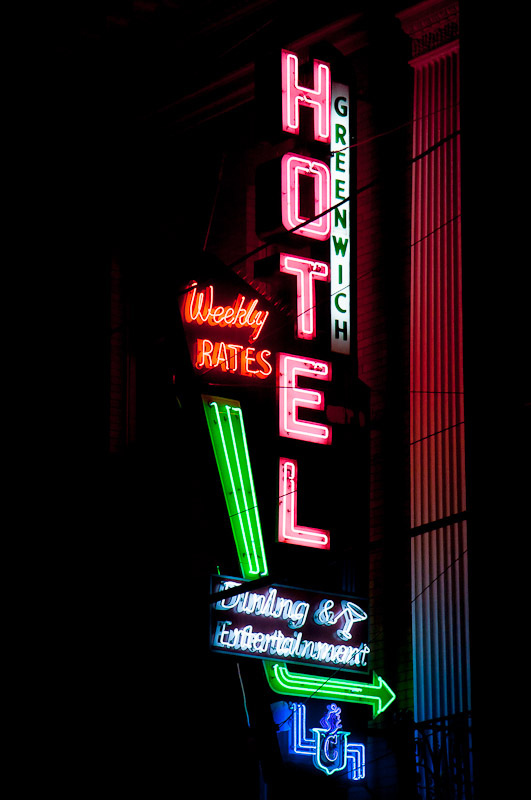
Hively still shoots neon she sees while traveling, like this this lovely hotel sign she discovered in East Greenwich, Rhode Island. Photo by Hively.
You can find out more about Kirsten Hively’s Project Neon at her Tumblr and Flickr pages, and you can download her iPhone app or explore her Google map free. Learn more about Thomas E. Rinaldi’s research at New York Neon Blog.
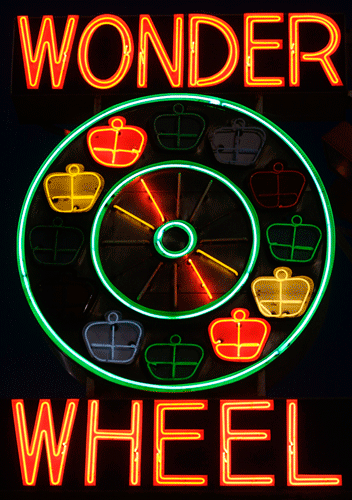
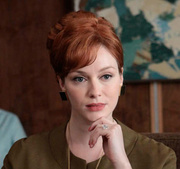
 Playing With Matches: Sexy, Silly 1930s Ads That Went Up in Smoke
Playing With Matches: Sexy, Silly 1930s Ads That Went Up in Smoke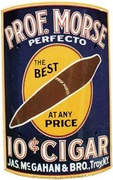
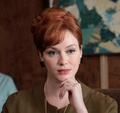 'Mad Men' Prop Master Scott Buckwald Explains How He Re-Creates the '60s
'Mad Men' Prop Master Scott Buckwald Explains How He Re-Creates the '60s Playing With Matches: Sexy, Silly 1930s Ads That Went Up in Smoke
Playing With Matches: Sexy, Silly 1930s Ads That Went Up in Smoke The Disappearing Art of Porcelain Signs
The Disappearing Art of Porcelain Signs Neon SignsThe first neon advertising sign was used for a Parisian barber in 1912. Sin…
Neon SignsThe first neon advertising sign was used for a Parisian barber in 1912. Sin… Mari Tepper: Laying it on the Line
Mari Tepper: Laying it on the Line Nice Ice: Valerie Hammond on the Genteel Charm of Vintage Canadian Costume Jewelry
Nice Ice: Valerie Hammond on the Genteel Charm of Vintage Canadian Costume Jewelry How Jim Heimann Got Crazy for California Architecture
How Jim Heimann Got Crazy for California Architecture Modernist Man: Jock Peters May Be the Most Influential Architect You've Never Heard Of
Modernist Man: Jock Peters May Be the Most Influential Architect You've Never Heard Of Meet Cute: Were Kokeshi Dolls the Models for Hello Kitty, Pokemon, and Be@rbrick?
Meet Cute: Were Kokeshi Dolls the Models for Hello Kitty, Pokemon, and Be@rbrick? When the King of Comedy Posters Set His Surreal Sights on the World of Rock 'n' Roll
When the King of Comedy Posters Set His Surreal Sights on the World of Rock 'n' Roll How One Artist Makes New Art From Old Coloring Books and Found Photos
How One Artist Makes New Art From Old Coloring Books and Found Photos Say Cheese! How Bad Photography Has Changed Our Definition of Good Pictures
Say Cheese! How Bad Photography Has Changed Our Definition of Good Pictures Middle Earthenware: One Family's Quest to Reclaim Its Place in British Pottery History
Middle Earthenware: One Family's Quest to Reclaim Its Place in British Pottery History Fancy Fowl: How an Evil Sea Captain and a Beloved Queen Made the World Crave KFC
Fancy Fowl: How an Evil Sea Captain and a Beloved Queen Made the World Crave KFC
Great article. We have a few cool neon signs left in my town, Lima, Ohio, which was home to the famous Neon Products sign company, one of the largest neon sign makers in the world.
( http://www.bluffton.edu/courses/tlc/bushp/video.htm )
This is ace. love neon. i dont think u could ever do this in the uk.
You might want to check out New Orleans for their neon signage…a google image search will do. I think it’s silly that some New Yorkers think the entire world is represented in their city. If neon signs disappear in NY; it doesn’t mean their heyday is over…
Not a mention of London’s Piccadilly circus with it’s Schwepp’s neon sign (or was it Coke?) and many, many others. I loved seeing the neon lights when I was a child in the 60s and 70s. There’s something special about them. It’s not so good now.
VEGAS BABY..THE BEST ..
Great article! If you’re not already familiar with you could check out the amazing old neon signs in the city of Vancouver on Canada’s west coast.
I Love your article…I too have been in love with Neon signs and it is part of Americana that is fading away. I travel for work so I have the opportunity to shoot Neon signs all over the country. I have a question for you, I see that you use a 50mm lens. What type of camera do you use? Do you use a tripod and what are the settings on the camera are you using?
Thanks Boyd
I can remember back in the 60s when the “critics” hated neon.Likened it to urban eyesore.
How these hypocrites can change their stripes.
Worse than Judas Iscariot
Wonderful article! Love the salesman’s suitcase. For more on the science and history of neon gas and lighting, check out this 2012 article from the Chemical Heritage Foundation’s magazine: “A Blaze of Crimson Light: The Story of Neon,” https://www.chemheritage.org/distillations/magazine/a-blaze-of-crimson-light-the-story-of-neon (disclosure: I’m one of the authors). We have some nice signs here in Philadelphia, as well as a very talented neon designer and collector named Len Davidson, author of Vintage Neon (1999). Here’s his website: http://www.davidsonneon.com/ .